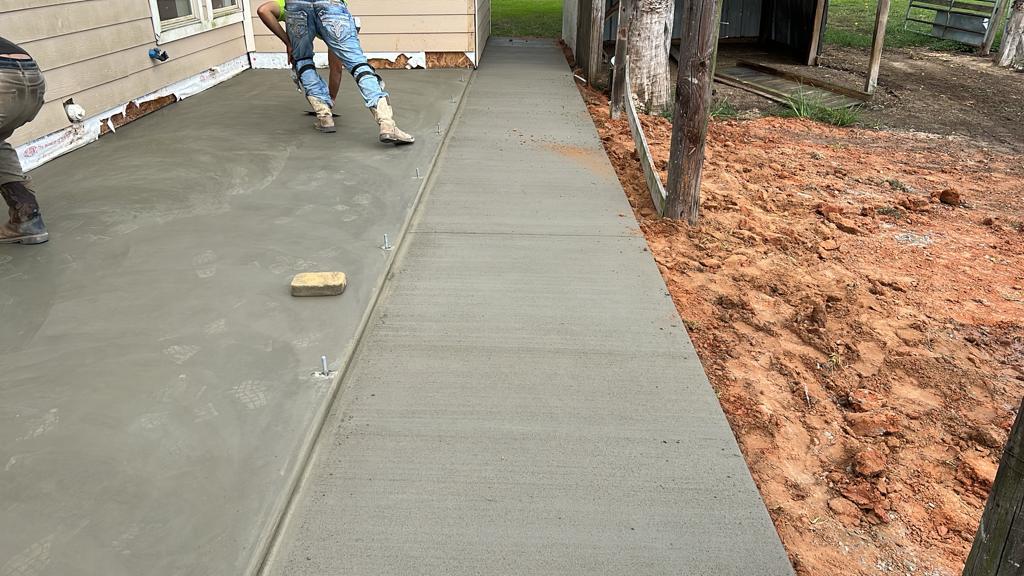Sidewalks Building
Contact us today for a free estimate (832) 537-2919

Sidewalk Building Service
At Alejo’s Concrete Service, we specialize in creating safe, functional, and aesthetically pleasing sidewalks. Our commitment to quality ensures that pedestrians can move freely while enjoying well-designed urban spaces.
By choosing Alejo’s Concrete Service, you’re investing in well-designed sidewalks that enhance urban mobility, safety, and quality of life. Let’s build better sidewalks together!
Sidewalks installation
Certainly! Installing concrete sidewalks involves several critical steps to ensure durability, safety, and visual appeal. Let’s walk through the process:
Site Preparation:
- Clear the Area: Remove any existing vegetation, debris, or obstacles.
- Mark the Path: Outline the sidewalk’s location using stakes and string lines.
Excavation:
- Dig the Trench: Excavate the soil to the desired depth for the sidewalk. Typically, this is around 4 to 6 inches (10 to 15 cm).
- Grade the Base: Ensure a slight slope away from buildings or structures to prevent water accumulation.
Base Preparation:
- Add Gravel: Lay a compacted layer of gravel or crushed stone as the base material.
- Install Edging: Place concrete edging or forms along the sides of the trench to define the sidewalk’s shape.
Reinforcement:
- Steel Mesh or Rebar: Add steel reinforcement to enhance the sidewalk’s strength and prevent cracking.
Concrete Pouring:
- Mix the Concrete: Prepare a concrete mix with the right proportions of cement, sand, and aggregate.
- Pour the Concrete: Fill the trench with concrete, ensuring it reaches the desired height.
Finishing:
- Screed and Float: Use a screed board to level the surface and a float to smooth it.
- Add Texture: Optionally, create a brushed or broom finish for better traction.
- Control Joints: Install control joints to prevent random cracking.
Curing and Protection:
- Cover with Plastic: Immediately cover the fresh concrete with plastic sheeting to retain moisture.
- Cure Properly: Allow the concrete to cure for at least 7 days, keeping it moist during this period.
Clean-Up:
- Remove Forms: Once the concrete has cured, remove the forms.
- Clean the Surface: Wash off any excess concrete or debris.
Sidewalks Repair and Maintenance
Proper sidewalk maintenance and repair is essential to ensure safety, accessibility, and longevity. Here are some key points to consider:
Common Maintenance Needs:
- Displacements: Address issues like uneven slabs or sunken sections.
- Surface Problems: Cracks, holes, and surface deterioration should be repaired promptly.
- Grades and Cross Slopes: Ensure proper drainage and accessibility.
- Other Issues: Maintain detectable warning fields, curb ramps, and other sidewalk elements.
Repair Methods:
- Temporary Measures: Quick fixes for minor issues.
- Short-Term Measures: Address problems that need attention within a few months.
- Long-Term Measures: Lasting solutions that may extend over a decade.
Infrastructure Repair Techniques:
- Grinding: Smoothen uneven surfaces.
- Crack Filling: Seal cracks to prevent water infiltration.
- Patching: Repair localized damage.
- Resurfacing: When extensive repairs are needed, consider resurfacing or replacing the entire sidewalk.
Remember that timely maintenance prevents tripping hazards and ensures safe pedestrian pathways.
Why Choose Us?
Expertise and Experience
We understand local regulations and design standards for sidewalks.
Attention to Detail:
From smooth finishes to proper grading, we leave no detail overlooked.
Customer Satisfaction:
Our transparent communication and reliable service set us apart
Quality Materials
Our commitment to quality ensures long-lasting results.
Contact Us Today
Ready to build your Sidewalk? Contact Alejo’s Concrete Services today for a free estimate. We’re here to help you create the perfect sidewalk for your Houston, Texas property.
FAQ's about Sidewalks
The 8 Principles of Sidewalks provide guidance for creating people-friendly streets. These principles include:
- Proper Sizing Elements: Designing sidewalks with zones for furnishing, pedestrians, and frontage.
- Universal Accessibility Elements: Incorporating features like curb ramps, tactile surfaces, and a consistent running slope.
- Safe Connections Elements: Ensuring safe crosswalks, street corners, and other urban spaces
- Building a concrete sidewalk involves several steps:
- Site Preparation: Clear the area and mark the path.
- Excavation: Dig the trench and grade the base.
- Base Preparation: Add gravel and install edging.
- Reinforcement: Use steel mesh or rebar.
- Concrete Pouring: Mix and pour the concrete.
- Finishing: Screed, float, and add texture.
- Curing and Protection: Cover with plastic and allow proper curing.
- Clean-Up: Remove forms and clean the surface2.
- Concrete sidewalk width depends on local guidelines and usage. Generally:
- Residential Sidewalks: 4 to 5 feet (1.2 to 1.5 meters) wide.
- Commercial Sidewalks: 6 to 8 feet (1.8 to 2.4 meters) wide.
- High-Traffic Areas: Wider sidewalks for more pedestrian flow3.

